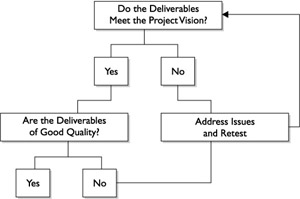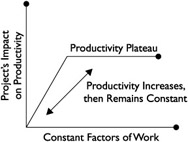The Project Postmortem
The final task has been completed, and there s a collective sigh of relief from all of the parties. But, sorry, you ve still got a touch of work left to go on the project. Once all of the implementation tasks in the critical path have been completed, a project manager and the project team must do a few chores to inspect their own work. This time should be worked into the PND and shouldn t take very long at all, maybe 1 to 3 percent of the total project time.
Reviewing for Quality
The primary task that you personally must be involved with is to inspect the quality of the project. Of course, throughout the implementation you will be sampling the project and confirming the quality, but at completion you need to experience or test the project deliverables and confirm that they are the required deliverables to complete the project. You want to perform a final inspection before the project customer sees the deliverable . The point of this inspection is to correct the mistakes that may be present before the customer sees the deliverables during its scope verification process.
To do this, re-create the experience that a typical user would have when using the deliverables. If your project produced an application, use it. If the project was to implement a network, log into a workstation and test connections, print to a few printers, and access some network resources. Evaluate the product from the end user s point of view and review the results to determine if the project deliverables are acceptable, as seen in Figure 12-4.

Figure 12-4: The process must be in place to test the quality of the project deliverables.
If you encounter problems, address them immediately so that the responsible parties can react to them and find a solution. At this point of the project, if you ve done your job, there shouldn t be any major surprises . You may encounter a quirk that can be quickly addressed and solved , but overall, things should be smooth and the customer happy.
Assessing the Project Deliverables
Once you ve completed the final inspection and the quality of the work is acceptable and in alignment with the expected project deliverables, you can enjoy the sense of satisfaction that comes from the success of completing a project. There is a wonderful feeling that comes with taking a project from start to finish. The project is now part of the company s life, and you helped get it there.
Examining the Project s Worth
Now that the project is complete, you may want to calculate the worth of the project. This activity involves a bit of math magic, but it allows you to predict the overall usefulness and profitability of your implementation. You calculate the time saved, the new sales earned, and the productivity gained to create a gross value of the project. The expense of the project, the total cost of the implementation, is subtracted from the gross value of the project to learn the project s net value. From here you can create formulas to predict the value of the project over the next six months, the next year, or beyond.
Don t get too excited by the math, however, because eventually the infrastructure processes of the company will absorb your deliverables as a matter of doing business. What happens is that your project s deliverables, the wonderful things that they are, will fall victim to the Law of Diminishing Returns . In other words, the twenty minutes you take out of a process will be consumed by some other activity.
The Law of Diminishing Returns , sometimes called the Law of Variable Proportions , is a rule of economics that grew from Thomas Malthus Essay on the Principle of Population, written in 1798. The law states that if one factor of production is increased while other factors remain constant, the overall returns will eventually decrease after a certain point, as demonstrated in Figure 12-5.When that point is reached is difficult to say without serious analysis given to the process of a company.

Figure 12-5: The Law of Diminishing Returns prevents exponential productivity.
Another way of viewing the Law of Diminishing Returns is to imagine a cornfield that needs to be harvested. If you were to continue to add workers to the field, each new worker you added would have less to do than the worker added before him because there is less and less corn to harvest as additional labor is added.
To apply this law to a technical implementation, imagine a new application that allows workers to be more productive when entering human resource forms and typical paperwork. Before the application, the workers had to manually enter the forms into Microsoft Excel, save the file, and e-mail it to the human resources department. The wonderful folks in human resources would open the e-mail, open the file, and merge it into some master file.
Your application streamlines the process through an ASP web page and pumps the information into a database. Now when users within the company need to complete insurance forms, request days off work, request new ID badges, or deal with any other HR- related issue, they can complete the process through your company s intranet.
The productivity of this application allows the processes to be faster, better, and easier to complete. However, this level of productivity will not affect other areas of the workers roles in the organization exponentially. It will allow for additional time to complete other work, but the additional time gained does not continue to grow on, and on, and on. Eventually the productivity reaches a plateau, and the Law of Diminishing Returns reigns.
All of the project s worth may not be measured in immediate finances. The success of the project may create a feeling of satisfaction, new pride in the company, and general happiness throughout the company driven by the benefit of the new technology. For example, a project that replaces an outdated and lagging technology with a new, proven technology can ease headaches and spur productivity.
Third-Party Review
A final method to measuring the worth of a project s deliverables to an organization is to call upon a third party to analyze the before-and-after processes of a company. For example, imagine an implementation of a wireless Personal Digital Assistant (PDA) in a manufacturing environment. The goal of this project is to shorten the process a forklift operator must use to deliver a palette of the product to a delivery truck.
In the before example, workers pick up palettes of the goods the company manufactures and then move the palettes to the trucks that will deliver the product to the stores and merchandisers. The problem this project resolves is that workers, after dropping off their palettes in the delivery trucks, would have to drive the forklift back to a central base to get their next assignment of the product to be loaded on the trucks .
The project created a wireless PDA device that will send a message to the forklift operator on the floor to instruct him on the next product he is to pick up and deliver to a specific truck. The process has been improved; the worker does not have to return to the central base. Additionally, the palettes, which are wrapped in plastic, have a bar code that the worker can scan from the forklift to log the goods that are actually placed onto the delivery truck. All steps within the process are logged and can be analyzed from the start of the process to the end of a workshift.
A third party could evaluate the productivity before the implementation and after. The process analysis would allow the consultants to track the amount of product moved per workshift to predict the average amount of productivity before and after the implementation. That information can then be analyzed and tweaked, and the original project deliverables can be adjusted in a new project to streamline the process again.
To complete the project, the information gathered by the completed process would be analyzed and reviewed internally or externally. The review would allow the company to see a true ROI and productivity gained on the implementation. Far too often, organizations don t invest in the time to validate the promised benefits of the project. The verification of the benefits is needed not only to show the return on investment for the current project, but to afford success in future projects.
EAN: 2147483647
Pages: 195